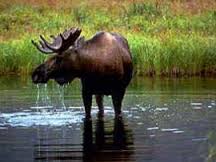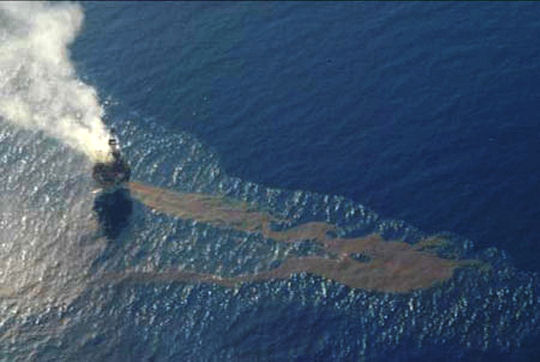|
|
|
|
|
|
|
|
5th European Conference on Permafrost, June 23-July 1, 2018 (Chamonix-Mont Blanc, France). In the continuation of the International and Regional conferences convened by the International Permafrost Association, the 5th European Conference on Permafrost (EUCOP 2018) will be held in Chamonix-Mont Blanc, France, 23rd June - 1st July 2018. The conference aims at covering all relevant aspects of permafrost research, engineering and outreach on a global and regional level. Conference website: here.
|
Media
Archaeologists Race Against Time to Save Sites from Climate Change. An international group of archaeologists-in a race against time to preserve, or at least document, artifacts and sites threatened by coastal erosion, melting glaciers and permafrost thaw-have published the first synthesis of how climate change is affecting Arctic archaeological sites in the journal Antiquity. The group of experts, associated with universities, governments and museums and the US National Park Service from the U.S., Canada, Denmark, Norway, Russia and Scotland, combed through national cultural heritage databases to determine that at least 180,000 archeological sites exist in the Arctic. Union of Concerned Scientists
 Arctic Ocean Climate Change Due to Fast Warming of Top Ice Layer. Arctic Ocean Climate Change Due to Fast Warming of Top Ice Layer. After the Atlantic Ocean, it is the turn of Arctic Ocean to experience the warming effect at a faster rate. According to the research study released on Mid-June, scientists warned that the rising sea level in the Antarctic Ocean due to the ice melting in the West Antarctica region and within a decade, more than the expectation, ice melted triple times faster and overall, about 3 trillion tons of Antarctic ice has melted in the past 25 years from 1992. According to a recent study on Arctic Sea, a rapid rise of 1.5 degrees Celsius (2.7 degrees Fahrenheit) has been recorded since 2000 in the northern Barents Sea in Scandinavia. It could be called as the Arctic warming hotspot as commented by a researcher from the Institute of Marine Research in Norway and if it is continued, it would get transformed into an upper part of Atlantic Ocean by the end of the 21st century as indicated by the simulations. MicroCap Observer
Scientists Study Spring Transition in Bering Strait Waters. The Bering Sea is getting warmer. That's a pretty commonly accepted trend, and in Western Alaska, it looks like a lot less sea ice. But there are lots of details about how this affects marine life that we don't really understand. And scientists are trying to figure some of those out. For the past two summers, University of Alaska Fairbanks oceanographer Seth Danielson has led a team of about 20 scientists aboard the research vessel Sikuliaq, as they study the spring transition in the Bering and Chukchi seas. Alaska Public Radio
 Artificial Intelligence Used to Track World's Wildlife. Artificial Intelligence Used to Track World's Wildlife. Scientists have long struggled with how to measure the effects of climate change on wildlife. This is especially true for birds flying in and out of coastal areas bordering the Arctic Ocean. In the past, researchers depended mainly on information gathered by satellite to follow the movement of birds and animals. But this method can be costly and result in huge amounts of information, which can be difficult to process. Voice of America
|
|
Future Events
 Coastal Response Research Center Requests Input on the State of Science on Dispersant Use in the Arctic. The Coastal Response Research Center (CRRC) recently collected statements and reports on five topic areas related to dispersant use in the Arctic: efficacy and effectiveness; physical transport and chemical behavior; degradation and fate; eco-toxicity and sublethal impacts; and, public health and food safety. CRRC request written input on the statements the scientists made on the state-of-the-science regarding dispersant use, particularly as it applies to Arctic waters. Written comments are requested by July 13th. More information on this initiative is available here. Coastal Response Research Center Requests Input on the State of Science on Dispersant Use in the Arctic. The Coastal Response Research Center (CRRC) recently collected statements and reports on five topic areas related to dispersant use in the Arctic: efficacy and effectiveness; physical transport and chemical behavior; degradation and fate; eco-toxicity and sublethal impacts; and, public health and food safety. CRRC request written input on the statements the scientists made on the state-of-the-science regarding dispersant use, particularly as it applies to Arctic waters. Written comments are requested by July 13th. More information on this initiative is available here.
17th International Congress of Circumpolar Health (ICCH17), August 12-15, 2018 (Copenhagen, Denmark). The ICCH congresses are held every third year in different locations in the circumpolar area and represent the largest scientific meetings worldwide on circumpolar health. The ICCH congresses serve as the primary source of information exchange and scholarly communication in issues relating to circumpolar health. More than 750 participants generally register and participate in each Congress, and more than 400 scientific papers or posters are usually presented.
UArctic Congress 2018, September 3-7, 2018 (Oulu and Helsinki, Finland). The UArctic Congress 2018 will bring together key UArctic meetings and a science conference into one single gathering, including business meetings of the Council of UArctic, Rectors' Forum, Student Forum, and Thematic Networks & UArctic Institutes Leadership Team. The Congress is an integral part of the Finland's Arctic Council chairmanship program, and open to the public. The event will highlight the themes and priorities of the Finnish chairmanship, including the goals of the United Nations' 2030 Agenda for Sustainable Development, and the Paris Agreement under the UN Framework Convention on Climate Change.
Scientific Exploration of the Arctic and North Pacific (SEA-NorP), September 25-27, 2018 (Mt. Hood, Oregon USA). This workshop will include discussion of hypotheses that can be tested by scientific drilling in the region, the technology necessary to achieve those goals, ideal sites for drilling based on existing data, and where additional site survey data is needed. The goal of the workshop organizers is that multiple proposals will be initiated at the workshop, both for full cruise legs and for shorter, targeted expeditions around the following themes: ocean gateways, geohazards, volatile cycling, ice histories at transition zones, biosphere and climate.
The second Arctic Biodiversity Congress is hosted by the Conservation of Arctic Flora and Fauna (CAFF), the biodiversity working group of the Arctic Council, and the Ministry of the Environment, Finland. The second Arctic Biodiversity Congress will build on the success of the first Congress, held in 2014 in Trondheim, Norway, and will bring together scientists, policymakers government officials, Indigenous representatives, Traditional Knowledge holders, industry, non-governmental organizations, and others to promote the conservation and sustainable use of Arctic biodiversity.
|
|

  
4350 N. Fairfax Drive, Suite 510
Arlington, VA 22203, USA
External links in this publication, and on the USARC's World Wide Web site ( www.arctic.gov) do not constitute endorsement by the US Arctic Research Commission of external Web sites or the information, products or services contained therein. For other than authorized activities, the USARC does not exercise any editorial control over the information you may find at these locations. These links are provided consistent with the stated purpose of this newsletter and the USARC Web site.
|
|
|
|
|
|
|
|
|
 Arctic Ocean Climate Change Due to Fast Warming of Top Ice Layer. After the Atlantic Ocean, it is the turn of Arctic Ocean to experience the warming effect at a faster rate. According to the research study released on Mid-June, scientists warned that the rising sea level in the Antarctic Ocean due to the ice melting in the West Antarctica region and within a decade, more than the expectation, ice melted triple times faster and overall, about 3 trillion tons of Antarctic ice has melted in the past 25 years from 1992. According to a recent study on Arctic Sea, a rapid rise of 1.5 degrees Celsius (2.7 degrees Fahrenheit) has been recorded since 2000 in the northern Barents Sea in Scandinavia. It could be called as the Arctic warming hotspot as commented by a researcher from the Institute of Marine Research in Norway and if it is continued, it would get transformed into an upper part of Atlantic Ocean by the end of the 21st century as indicated by the simulations. MicroCap Observer
Arctic Ocean Climate Change Due to Fast Warming of Top Ice Layer. After the Atlantic Ocean, it is the turn of Arctic Ocean to experience the warming effect at a faster rate. According to the research study released on Mid-June, scientists warned that the rising sea level in the Antarctic Ocean due to the ice melting in the West Antarctica region and within a decade, more than the expectation, ice melted triple times faster and overall, about 3 trillion tons of Antarctic ice has melted in the past 25 years from 1992. According to a recent study on Arctic Sea, a rapid rise of 1.5 degrees Celsius (2.7 degrees Fahrenheit) has been recorded since 2000 in the northern Barents Sea in Scandinavia. It could be called as the Arctic warming hotspot as commented by a researcher from the Institute of Marine Research in Norway and if it is continued, it would get transformed into an upper part of Atlantic Ocean by the end of the 21st century as indicated by the simulations. MicroCap Observer  Artificial Intelligence Used to Track World's Wildlife. Scientists have long struggled with how to measure the effects of climate change on wildlife. This is especially true for birds flying in and out of coastal areas bordering the Arctic Ocean. In the past, researchers depended mainly on information gathered by satellite to follow the movement of birds and animals. But this method can be costly and result in huge amounts of information, which can be difficult to process. Voice of America
Artificial Intelligence Used to Track World's Wildlife. Scientists have long struggled with how to measure the effects of climate change on wildlife. This is especially true for birds flying in and out of coastal areas bordering the Arctic Ocean. In the past, researchers depended mainly on information gathered by satellite to follow the movement of birds and animals. But this method can be costly and result in huge amounts of information, which can be difficult to process. Voice of America

